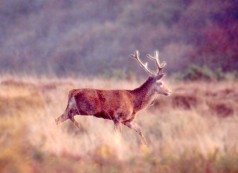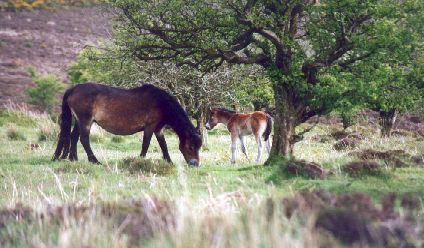The Exmoor National Park (ENP)
The Exmoor National Park was designated in 1954 and covers 267 square miles (692sq.km.). Two thirds of the
park is in the County of Somerset and one third is in Devon. The landscape is described as 'semi-natural' as it
has been influenced by human activity over thousands of years.
At the end of the Ice Age (10-12,000 years ago) the climate improved and vegetation began to grow. It is believed
that 8,000 years ago the majority of Exmoor was continuous oak woodland. As man began to settle, the Exmoor landscape
changed as agricultural 'technology' and ways of life evolved. The result of this human interaction is the
wonderful diversity and variety that is Exmoor today.
What does Exmoor look like today ?
-
High rolling moorland. Approximately 27% of the Exmoor National Park is actually 'moorland'. The rest is mainly farmland. Both the heather and grass moors are internationally important for their wildlife and scenic beauty. High ground of this nature is unusual in southern England.
The Exmoor 'plateau' is an area of unglaciated upland (250-500m) approximately 200 million years old - some 180 million years older than the Alps in Europe. It is thought to rank among the oldest features on the Earths surface. -
A rugged coast. Exmoor's northern boundary (34 miles/54km) is the Bristol Channel and stretches from Combe Martin to Minehead. The cliffs along this coastline mainly face North or NE and are protected from the prevailing South Westerly winds. They are the highest cliffs in England (Great Hangman is the highest sheer cliff at 800ft/244m). The sheltered aspect has allowed the development of coastal woodland which is predominantly oak. The woods between The Foreland and Porlock represent the longest stretch of coastal woodland in England and Wales and run right down to the shore in many places. The rare Exmoor 'hogs-back' cliffs are dramatic and awe-inspiring. The Exmoor coast is one of the most unspoilt and best protected stretches of coastline in England and Wales.
-
Ancient woodlands. Much of Exmoor's high ground features steep, woodland covered valleys (called combes). Much of the woodland is ancient sessile oak. Birch, beech, ash, rowan, unique varieties of whitebeam and various 'thorns' also feature.

Stag on Anstey Common
-
Rivers and streams. The very nature of the Exmoor area has determined that the only farming possible on the high ground is sheep or cattle grazing. So there is very little to pollute Exmoors watercourses. The relatively fast flowing brooks and streams support a wide variety of plants and animals, including otters, kingfishers, goosanders, salmon and trout (see fishing).
-
The 'cultural' landscape. Dotted across this wild, 'natural' place are the farmsteads, villages and hamlets where the people who have shaped Exmoor have lived and worked for generations.

Exmoor ponies - Dunkery Beacon in the background
Exmoor's Special Features
Geology
Exmoor is made up of sedimentary rocks (grits, siltstones, sandstones, mudstones) which show a slaty cleavage; the rock
has been altered under pressure so that it is split into flat plates. They are mainly of Devonian Age. They
are special because they show an uninterrupted sequence through the Devonian into the succeeding Carboniferous period
(385-355 million years ago). Devon and Exmoor was the first area where rocks of this age were studied - hence the
name.
Unusually smooth and convexly rounded hillsides are a special Exmoor feature. The Hogs-back cliffs
owe much of their shape to weathering and erosion during the Ice Age.
Changes in sea-level are responsible for other landform features such as the Valley of Rocks (Lynton), the coastal
waterfalls, the Lyn Delta, the cobble or shingle ridge and submarine forest at Porlock (see top picture). There
are unusual knolls within inland valleys such as Cow Castle (beside the river Barle below Simonsbath), Flexbarrow and
Alse Barrow which appear to be fragments of river terraces.

Cow Castle in the Barle Valley (site of an ancient fort)
Rare Habitats
Exmoor contains 5 broad types of habitats which are recognised as being of international importance; blanket bog, upland
heath, western heath, western oakwoods and parkland. The UK has 10-15% of the worlds blanket bog and wet moorland
and a large proportion of its upland and western heaths. Exmoor has a significant proportion of the UK and world
total of western oakwoods.
Exmoor also has some particularly rare and internationally important plant communities;
Lichens, bryophytes and fungi of coastal heaths, cliffs and shore;
Western oakwoods;
Old parkland trees;
Purple moorgrass/meadow thistle grassland;
Ash/rowan woodland;
Bristle bent /western gorse heath.
The Exmoor Pony is considered to be a race of wild horse rather than a separate species. It is classified as an
endangered breed by the Rare Breeds Survival Trust. The
Exmoor Pony Society Homepage
Exmoor is thought to have two endemic species of whitebeam tree (Sorbus subcuneata and Sorbus Taxon D). (These are
native to Exmoor and found nowhere else).
Lichen Opegrapha fumosa is also thought to be endemic to Exmoor.
Internationally endangered species found on Exmoor include; many species of spiders and insects, including high
brown fritillary and heath fritillary butterflies; 10 species of bat; otter; water vole; brown hare; dormouse; goshawk;
merlin; peregrine; red grouse; grey partridge; quail; curlew; guillemot; barn owl; redshank; Dartford warbler;
razorbill; nightjar; Cetti's warbler; sedge warbler; lapwing. Plants include the whitebeams,
Babington's leek, fragrant evening primrose and six species of fungi.
Other nationally important species which, although not rare, are relatively abundant on Exmoor include:
red deer, whinchat, stonechat, Irish spurge, ivy-leaved bellflower, alternate water milfoil, Cornish moneywort, the
'sausage' lichen Usnea articulata, lichens Rinodina fimbrata and Rinodina flavosoralifera.

Exmoor pony and foal on Winsford Hill
Hedgebanks
These are unusual features both nationally and internationally and are confined to the West Country (Somerset, Devon
and Cornwall). They feature widely on Exmoor as field and common boundaries. They consist of a bank of
earth, typically 1-2metres high with a hedge growing on top. Sometimes the sides of the bank have 'ditching' -
faced with stone which varies in character across the Moor. In the early 19th century the Acland family
(landowners with a huge estate on the Moor) experimented with various forms of hedge to top the banks and found that
beech was the most successful. Beech grew higher on Exmoor than elsewhere, was of low 'logging' value so the
locals left it alone (!) and when thinned and 'layed' formed a good wind and stock proof barrier.
The Knights (see Simonsbath) used beech extensively in the mid 19th century during
their huge moorland reclamation project.

A "Hedgebank" north of Exford
Buildings and Monuments
There are 162 Scheduled Monuments and 1011 Buildings of Special Architectural or Historic Interest (Listed Buildings)
on Exmoor. Monuments include prehistoric remains such as standing stones, stone circles, barrows, forts and later,
packhorse bridges.
An unusual feature on Exmoor is the continuity of settlement in some places from the Iron Age onwards.
Grade 1 secular Listed Buildings on Exmoor are:- Bratton Court, Combe Sydenham,
Dunster Castle, Dunster Yarn Market,
Gallox Bridge, Nettlecombe Court, Tarr Steps.
Grade 1 Listed Churches on Exmoor are:- Culbone, Dunster, Luccombe, Monksilver, Nettlecombe,
Porlock, Selworthy,
Timberscombe, Winsford, Wootton Courtenay, St. Petrock's at Parracombe.
The Exmoor National Park Authority
The Exmoor National Park is the place.
The Exmoor National Park Authority (ENPA) is the organisation that is charged by central government to
administer the policies and legislation the refers to National Parks in the UK.
Who are the Authority?
The ENPA consists of a committee of members from various sources;
5 Somerset County Council elected members
2 Devon County Council elected members
5 West Somerset District Council elected members
2 North Devon District Council elected members
5 Parish Council elected members
7 Secretary of State (for the Environment) Appointees (for their special knowledge and national perspective)
---
26 Members Total
ENPA is a 'free-standing' body within the local government structure, but independent of County and District councils. The Authority meets on a regular basis to decide policy, resource allocation and planning issues.

Exmoor House - ENPA Headquarters
How is the ENPA Funded?
The majority of the money comes from central government through an annual bid to the DETR (Department of the Environment, Transport and the Regions). The remainder comes from the constituent local authorities who also get support from central government to meet these costs. The ENPA also generates additional income from it's own activities and attracts considerable sums from external sources. Working in partnership with others, the ENPA is successful in attracting money from Europe, the National Lottery and Millennium funds and from Trusts and the private sector. An approximate breakdown of income sources would be;
60% central Government
19% local authorities
21% self generated, including additional funds from external sources.
ENPA Corporate Structure
This is headed by the National Park Officer - the Chief Executive. ENPA services are delivered through six professionally staffed sections:-
- Park Management
- Planning and Community
- Rangers
- Recreation and Tourism
- Education and Interpretation
- Business Management
The ENPA headquarters is Exmoor House, Dulverton, Somerset, TA22 9HL.
tel: (01398)323665 fax: (01398)323150
E-mail: info@exmoor-nationalpark.gov.uk
Their web address is www.exmoor-nationalpark.gov.uk
Further Reading
On the ENP Authority website:-
Statement of the Economy of Exmoor
Annual Reports
Auditors Reports
Business Plans
Exmoor Local Access Forum Reports
Exmoor Local Plan Review
Exmoor State of Tourism Report
Sustainability Appraisal
